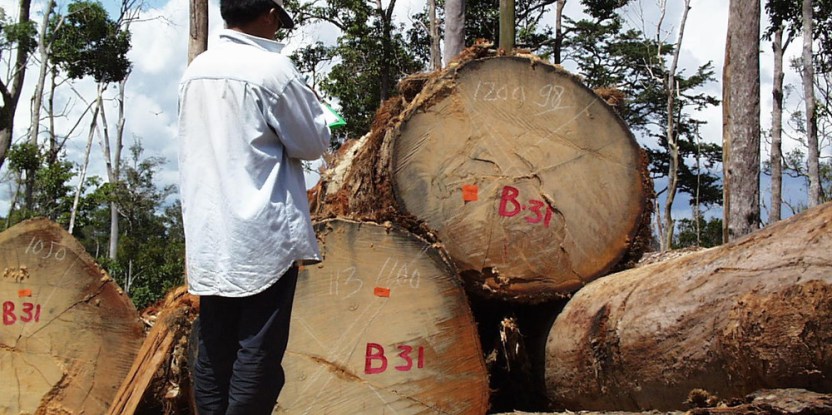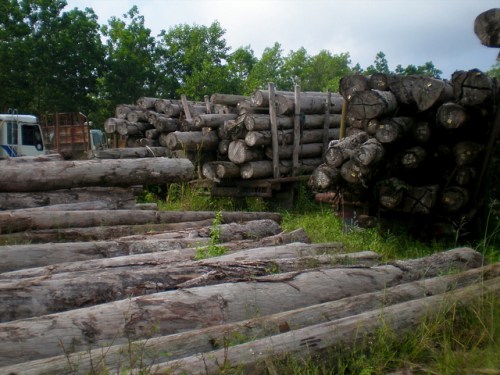
BOGOR, Indonesia — Timber harvested illegally in Africa, Asia and Latin America continues to be sold on world markets, despite international efforts to curb the trade. International systems meant to control the trade must work more closely together if they are to stem the tide, according to a new paper by Chatham House, a London-based policy institute, and the Center for International Forestry Research (CIFOR).
Regulations that took effect in the European Union (EU) in March 2013 prohibit the sale of illegally harvested timber and products made from illegal timber on the EU market. They also require buyers and sellers to ensure that their products can be traced all the way through the supply chain.
Those measures, known as the European Union Timber Regulation, complement the Convention on International Trade in Endangered Species of Wild Fauna and Flora (CITES), an international treaty aimed at ensuring that trade in wild animals and plants does not jeopardize their survival.
Experts say the two systems are complementary.
“CITES deals with a very specific set of legislation that aims at the protection of flora and fauna, while the EU Trade Regulation, which focuses on reducing the risk of illegal products entering the supply chain, is broader,” said Jade Saunders of Chatham House, who co-authored the study.
The European Union Timber Regulation is designed to keep illegally harvested timber and timber products out of EU markets. CITES requires countries to ensure that trade in endangered species does not threaten the populations of those species in their territories, said Rosalind Reeve, a senior research associate at CIFOR and co-author of the study.
The two systems can work together, but their approaches leave some gaps in regulation, Reeve said. Lack of coordination among agencies involved in enforcing the rules under the two systems can also undermine their effectiveness, Saunders added.
The EU Timber Regulation grew out of the Forest Law Enforcement, Governance and Trade (FLEGT) Action Plan, launched in 2003. The Timber Regulation requires anyone selling timber products in European Union markets for the first time to exercise “due diligence,” which involves providing information about the product and supplier and complying with laws in the source country.
Under European law, however, timber imports that comply with CITES requirements are exempt from the due diligence requirement, as are products licensed under FLEGT through Voluntary Partnership Agreements (VPAs). Such bilateral trade agreements offer preferential access to European markets to timber-producing countries that can ensure the legality of their timber exports.
Indonesia and five African countries — Cameroon, Central African Republic, Ghana, Liberia and Republic of Congo — have VPAs and are developing attendant regulations for monitoring and licensing. Another nine countries are negotiating agreements with the European Union, and 11 more have expressed interest, according to the European agency that oversees FLEGT.
Exempting CITES-approved imports from due diligence requirements creates a loophole, Reeve said, because the EU Trade Regulation (EUTR) and CITES use different measuring sticks to determine whether timber is legally harvested.
That said, more than a year after it came into effect, few EU countries have taken concrete steps to enforce the EUTR, according to Andrew Wardell, former director of CIFOR’s forests and governance program. “There is still widespread disagreement with respect to the scope of duties to be performed under the EUTR, and what constitutes adequate resourcing,” he said.
Under CITES, a tropical timber-producing country can issue export permits for timber harvested in accordance with laws protecting flora and fauna, as long as the harvest does not threaten the species’ survival. Rules for determining whether a harvest is legal are not consistent among CITES countries, Reeve said.
It’s critical that implementation and enforcement authorities for EUTR and CITES be communicating effectively and be familiar with each other’s systems
The European Union’s rules are more extensive, requiring traders to ensure that the timber was harvested legally under environmental and forestry legislation in the producer country; that land rights and worker health and safety laws were respected; and that exporters and importers complied with trade and customs laws.
By exempting CITES-licensed timber from due diligence, the European Union could be importing some timber or products that do not meet the stricter standards of the trade regulations, Reeve said.
“It’s critical that implementation and enforcement authorities for EUTR and CITES be communicating effectively and be familiar with each other’s systems,” she said.
One risk is that timber exported using fraudulent paperwork — a problem with bigleaf mahogany (Swietenia macrophylla) from Peru, according to a case study in the paper by Reeve and Saunders — could escape scrutiny. Another is that certain products made from CITES-listed species could be imported freely, because CITES does not specifically require export permits for those items.
Licenses granted under FLEGT should help reduce the misuse of CITES permits by requiring countries to set up control systems monitored by government agencies and independent auditors, but those systems are not yet operating, Reeve said.
To ensure that the EU Trade Regulation and CITES systems reinforce each other, authorities responsible for enforcing them in the various European countries must share and compare information, Saunders said.
CITES enforcement agencies in the various European countries already share an on-line database, EU TWIX, and Saunders is calling for a combined information system for both CITES and the EU Trade Regulation authorities.
She and Reeve make additional recommendations, including rating timber-exporting countries where the legality of CITES products is questioned; expanding CITES listings to include more processed wood products; consistent guidelines for assessing whether timber is “legal”; and expanding efforts to include Asian countries — a number of which have seen the emergence of new certification institutions — in the tracing of illegal products.
If some of those measures are implemented, along with codes of conduct for traders and voluntary agreements that define “legal” timber more clearly and establish monitoring systems in timber-producing countries, Reeve said, “you’ll increasingly see less illegal timber being traded in the European Union.”
For more information about the topics of this research, please contact Rosalind Reeve at roz.reeve@gmail.com.
We want you to share Forests News content, which is licensed under Creative Commons Attribution-NonCommercial-ShareAlike 4.0 International (CC BY-NC-SA 4.0). This means you are free to redistribute our material for non-commercial purposes. All we ask is that you give Forests News appropriate credit and link to the original Forests News content, indicate if changes were made, and distribute your contributions under the same Creative Commons license. You must notify Forests News if you repost, reprint or reuse our materials by contacting forestsnews@cifor-icraf.org.
